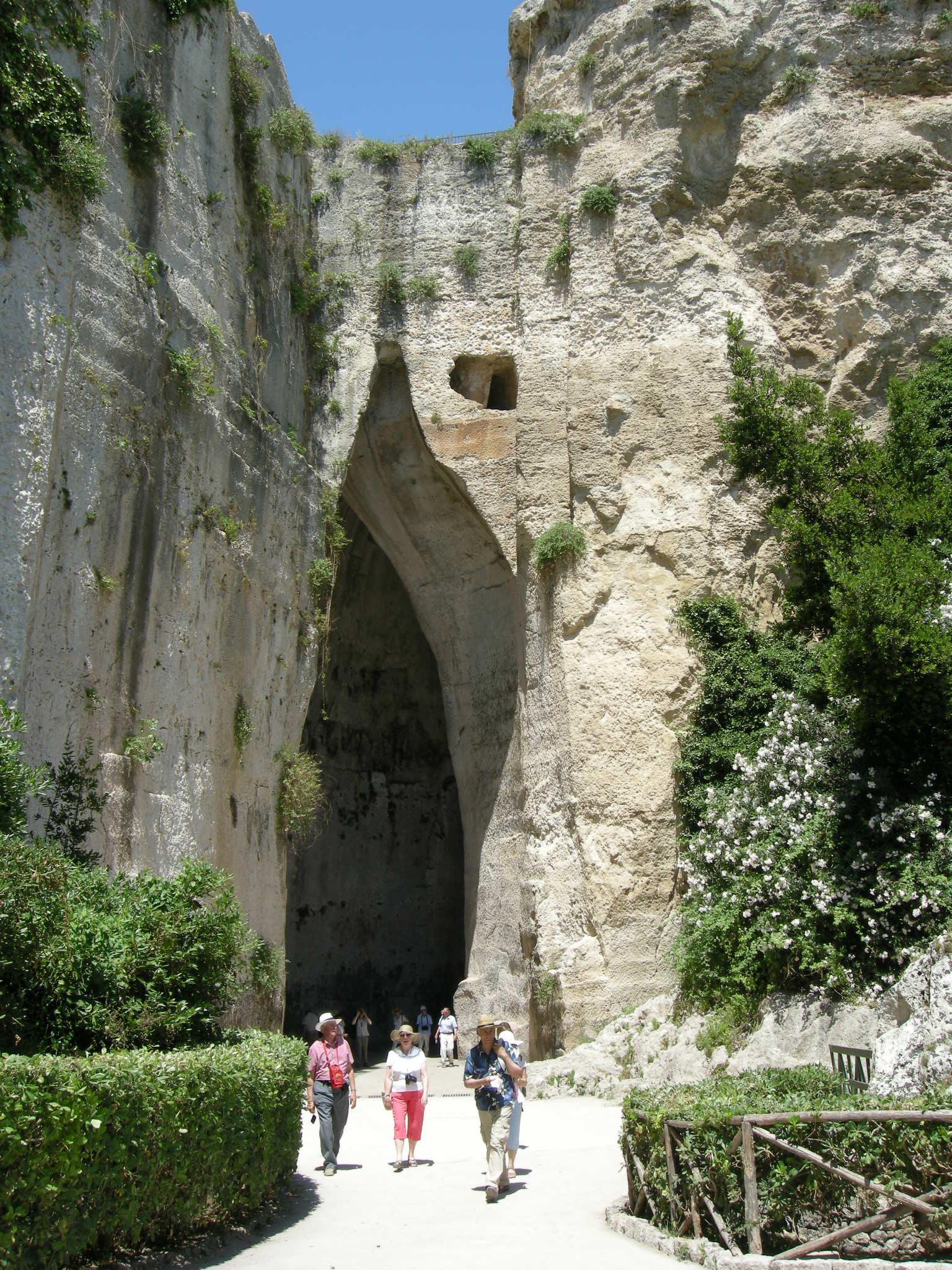Ear of Dionysius
Located on one side of the Latomia del Paradiso, there is a funnel-shaped cave carved into the rock, the Ear of Dionysius.
The cave is about 23 metres high, 5 to 11 metres wide and about 65 metres deep.
It is thought that its shape was dug from above by some stone quarrymen who were forced to follow the line of an ancient snake-shaped aqueduct present at that point.
Even today, there are no certain sources concerning the date of birth of this cave known as “Ear of Dionysius”.
Some researchers think that the cave served as a sound box for the Greek Theatre, not far from there, during the various exhibitions and that it was actually born only later than the rest of the Archaeological Park of Neapolis.
It took this name, given to it by Michelangelo da Caravaggio in 1608, precisely due to its “S” shape, vaguely similar to an earcup, but above all for its remarkable acoustic properties, as we can still testify nowadays, as the sounds are amplified up to 16 times.

The characteristics of the cave gave strength to the sixteenth-century legend according to which Dionisio, (military, dramatist and tyrant of Syracuse) had built this cave to be used as a prison, inside which he locked his prisoners, listening from an opening at the top (still visible) their possible plans to escape, as their words were magnified by the echo that this cave creates.
According to the reconstructions of the Roman philosopher and writer Eliano, Dionysius imprisoned the poet Philoxenus, accusing him of not having appreciated his literary works.
In 1770 the French painter and architect Jean-Pierre Houël visited the cave, as well as one of the most famous travellers on the Grand Tour (European Journey), carrying out a series of works. In his descriptions, he spoke of how tests were carried out in this cave to test its acoustics, blowing into a horn, firing a gunshot or tapping a drum.

But it is the legend of the place and its history that fascinates all tourists who come to visit this place.
He wrote in the “External view of the cave called Ear of Dionysius” as follows:
“Mirabella, born in Syracuse and author of a history of the city, informs us that this cave, called the Ear of Dionysius, was originally a quarry like the others designated as “Piscidina”. He narrates that important prisoners were locked up there during the reign of Dionysus and that the jailer, at a certain point in the tunnel, unknowingly, could listen to his speeches even if they spoke in a soft voice, due to the extraordinary effect of an echo produced by the shape of the cave. Once he was aware of their secrets, he told them to Dionysus. This is what is said, but also the pointed shape of the cave, perhaps, has contributed to give it the name of ear from which the legend was born. Outside, at the entrance of the tunnel, there must have been a staircase that led above the cliff, where there were the buildings that completed the dwellings of the prison, of which the cave was the secret. In this Ear or “Piscidina”, the tyrant Dionysius locked up the philosopher Philoxenus, with whom he had shown so much friendship, because he had not praised his verses.
In 1625 the writer and traveler Pietro Della Valle visited the Ear of Dionysius and was ecstatic about the grotto and in one of his works he wrote as follows:
“We witnessed the artificial echo that they say was made by Dionysius in a prison, where he kept many slaves, so that they could hear what they were talking about in there. It is indeed one of the most beautiful things I have seen in the world, and also of the artifacts that art has been able to invent, imitating so well nature that makes a beautiful echo that replicates the words and whole sayings, imitates sounds and songs perfectly, as in our presence with different instroments we tried; and if you beat with a rod some big cloth stretched out, it makes you so resound that it imitates the blows of the biggest artillery; and that all this does so well a cave formed not by nature, but by human artifice, is certainly strange and shows the great genius of him who invented and knew how to do it. It is not to be ignored that the factory of the concave of this cave is made and caved precisely in the shape of the concave of a human ear, from which the creator should take the invention that, as the voice beating in the ears manufactured in that way makes sound and is heard, so it is evident from experience that beating there in that great and artificial ear, carved by hand in the hard stone, has the same effect of making the sound, although we do not know that the other natural echoes are in caves thus manufactured. We saw near the place of the echo the great underground rooms quarried for room and prison of the above mentioned slaves, and above those, in the high place the place of the palace of Dionysus in beautiful site that overcame from long the earth and the sea”.
The writer and French art historian Dominique Vivan Denon, while visiting the cave, wanted to verify for himself the truth of the legend according to which Dionysius listened to the speeches of the prisoners, but understood that the overlapping of sounds makes listening completely confused:
“It is true that in the famous cave there is a small room, at the apse of the vault, where, it is said, that the listener came to place himself. So I decided to have him help me get into the room. I succeeded not without effort and here is what I saw: a room ten feet long and six inches on four feet wide that was shrinking to two feet and ten inches, […] I first put myself at the entrance to the cave. As long as there was only one person speaking in a normal tone, I felt it distinctly wherever it was in the cave, the same way I would hear it from below. When she spoke quietly, almost secretly, I heard a whisper and nothing articulate; and when two people spoke at the same time, I only heard a murmur of discordant and confused sounds that left no word to be distinguished. »
The French playwright and poet Guy de Maupassant, during his visit to Syracuse, also recounts the monument in his “Journey to Sicily”, writing as follows:
“In one, the Latomia of Paradise, one observes, at the end of a cave, a strange opening, called the Ear of Dionysius, who came to listen near this hole, so they say, the cries of their victims. Other versions also circulate. Some scholars claim that the cave, connected to the theatre, served as an underground hall for the performances to which it lent the echo of its prodigious sound; the slightest noise, in fact, takes on a surprising resonance.
OPENING HOURS AND PRICES
Location: Viale Paradiso – Parco Archeologico della Neapolis
Contacts.: +39 0931 489511
Archaeological site without architectural barriers
First Sunday of each month free entry.
Entry ticket to the Archaeological Park: Adults € 10.00 – Reduced € 5.00 (under 18) – Free entrance up to the age of 12.
Combined ticket for the Archaeological Park + a museum of your choice between the Paolo Orsi Museum or the Palazzo Bellomo Gallery – Ticket price: € 13.50 – Reduced € 7.00 (under 18) – Free admission until the age of 12
Opening hours of the ticket office: from 8.30 p.m. to 6.00 p.m.
PARKING OPENING HOURS: from 8.30 a.m. to 6.30 p.m.
From May 10 to July 18 the hours may vary, on the occasion of the tragedie greche that will be performed at the Greek theater.



